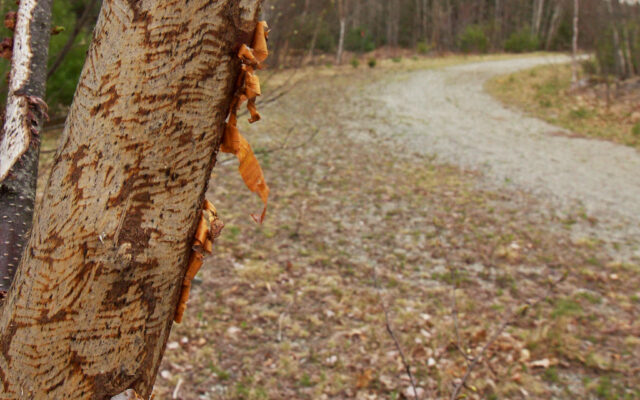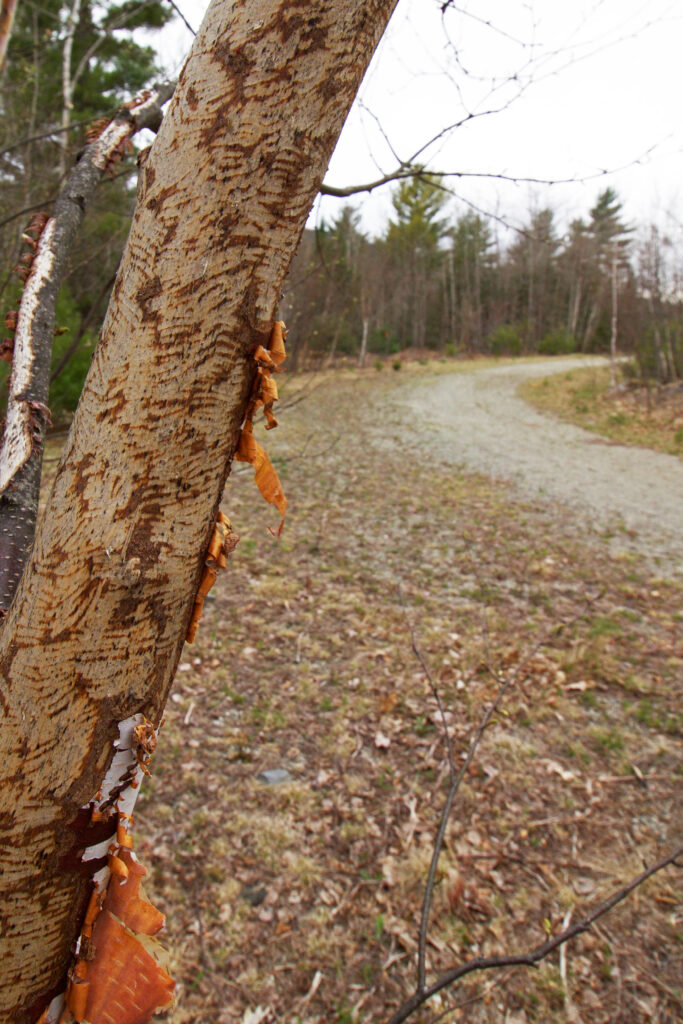
Here are some animal signs to look out for while hiking in Maine
By Aislinn Sarnacki
I don’t know about you, but I make quite a bit of noise when I hike. Dead leaves and fallen branches crunch under my boots. I frequently talk to my dog, and I occasionally whistle.
As a consequence, I don’t typically see much wildlife. But that doesn’t mean it’s not there.
Signs of wild animals can be found all along hiking trails, but they’re easy to miss. Noticing them can give you a better picture of the wilderness you’re exploring.
It can also signal you to keep an eye out for certain animals. If traveling quietly, you may catch a glimpse of a white-tailed deer or snowshoe hare as they bound through the bushes.

PORCUPINE SIGN – A tree covered with marks left by a hungry porcupine in the Hothole Valley Parcel of the Great Pond Mountain Wildlands.
I was reminded of animal signs recently while hiking with a friend.
“A squirrel feast!” I exclaimed, pointing to a pile of discarded pinecone scales.
She had no idea what I was talking about, so I explained: Squirrels eat the seeds out of spruce and pine cones, leaving behind piles of brown scales. Often, you’ll see these piles on downed trees or stumps, where a squirrel has perched to eat an entire cone or more.
When reading a landscape, animal signs are like words in a book, telling a story about the creatures that live there.
Tracks are one of the most well-known and studied signs of wildlife. In the winter, snow provides a canvas on which the footprints of animals tell complex tales. During other seasons, mud preserves tracks for days, whether on riverbanks or in a soggy section of the forest.
When studying to become a registered Maine guide, I learned the tracks of many of Maine’s common animals. The Maine Department of Inland Fisheries and Wildlife offers a helpful online cheat sheet. Some tracks, such as those made by turkeys, are quite distinctive, while others, such as chipmunks, squirrels and weasels, are difficult to tell apart.
Many signs have to do with the constant quest for animals to find food. For example, the pileated woodpecker hunts for insects by drilling rectangular holes in tree trunks. So a fresh cavity oozing sap means you’re in the right place to spot Maine’s largest woodpecker.
Porcupines and beavers also leave behind obvious evidence of their dietary habits. Both rodents strip bark off trees, leaving behind distinctive teeth marks.
But the beaver doesn’t stop there. It chews straight through trees, causing them to topple over so they can be used to construct dams and lodges.
I’ve seen some truly massive trees felled by beavers.
I pay particular attention to porcupine signs because they signal a potential threat to my canine hiking companion. Even though she is always on leash during hikes, I worry that I’ll turn the corner and run into one of these spiky creatures.
Covered in thousands of sharp quills, porcupines are abundant throughout Maine, and I often see signs of them along trails. In addition to gnawing bark off trees, they litter the ground with broken evergreen branches in their quest for cones and needles. They also leave pellets of poop that remind me of baked beans.
Animal poop, also known as scat, is another great way to tell what’s living near a trail. While some scat is challenging to identify, other types are unique.
Maine’s famous moose, for example, creates large piles of ball-shaped droppings that are similar to a deer’s but much larger. Snowshoe hares poop in neat, small, round pellets — scattered, not in a pile.
And during blueberry season, black bears often produce poop that looks remarkably like the filling of a blueberry pie.
Scat can also tell you what animals are eating, if you dare to take a close look. For example, I found a pile of bear poop near my house this spring, and it was filled with birdseed.
It made sense. Bears are known for raiding bird feeders, especially when natural sources of food are scarce early in the year.
Animal signs change throughout the year. For example, in the spring, a nest filled with eggs can tell you that a certain bird is nearby. While in the fall, you can find the fresh marks where deer have rubbed trees with their antlers.
If rushing along a trail, it’s easy to overlook the evidence left by animals. Or maybe you’d rather enjoy the beauty of the wilderness without inspecting it.
Sometimes I feel that way. But more often, I’m eager to know what might be hiding in the underbrush, just out of sight.